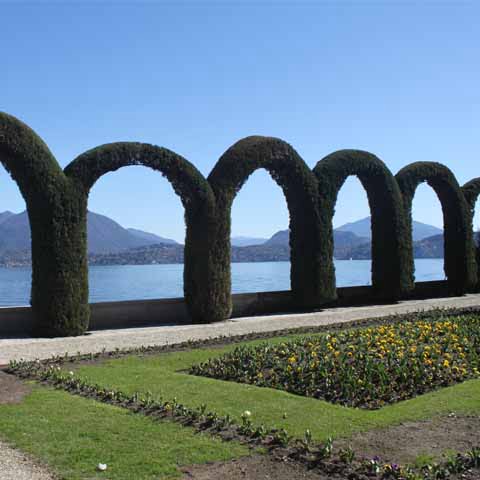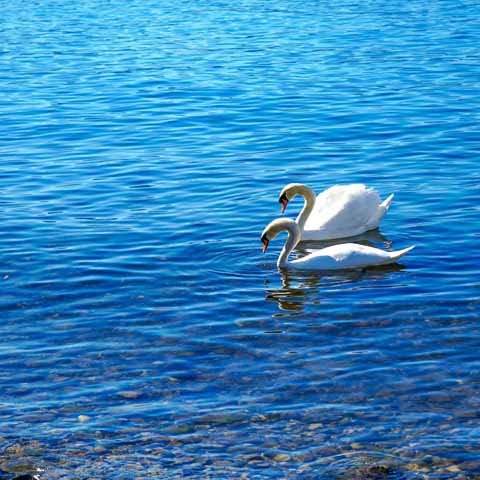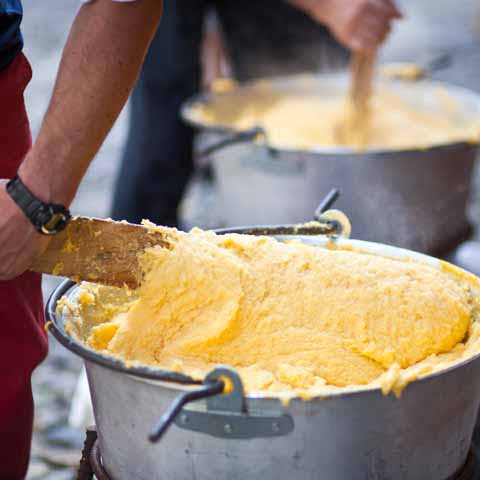On the northern border of Italy rests the stunning natural wonder of Lake Maggiore. This lake is the longest in Italy and is home to some of the most charming and picturesque towns and islands in the country. The area’s offerings of culture in local architecture, art, music, and more are as vast as the miles Lake Maggiore covers. Escape to the paradise of Lake Maggiore and let your soul rest and rejuvenate in this lovely area, which is one of the best kept secrets in Italy.
ARCHITECTURE
The crown jewel of the Lake Maggiore area is Palazzo Borromeo, still owned by the Borromeo family, which is situated on Isola Bella. This stunning palace sits on the northwest part of the island that directly overlooks the beautiful waters of the lake and was built in the seventeenth century at the request of Carlo III Borromeo in honor of his wife. Due to a plague epidemic, the palace was not completed until near the end of that century. Today visitors can admire several main halls, a noble floor, which was historically filled with rooms dedicated to music and art, and manmade artificial grottos.
Although most gardens are simply that, the magnificent gardens of the Borromean Island of Isola Bella defy the concept. The overall effect of the gardens is a pyramid shape in which one terrace leads to another until visitors finally reach the top. One of the main garden buildings here features open air archways that showcase gorgeous statues, a series of columns and stairways, and a plethora of beautiful flowers and greenery that make it feel like less of a building and more of a garden in the sky. Keep an eye out for the stunning white peacocks that roam the gardens and perch on the historic architecture.
Isola Madre, the largest island of Lake Maggiore, is renowned for its gardens. In fact, the island’s botanical gardens are among the oldest in Italy. Spanning nearly twenty acres along seven terraces, the area was originally designed as an English garden. Visitors to Isola Madre can expect to find cypress trees, wisteria, palms, and exotic flowers throughout the gardens coupled with colorful parrots, peacocks, and pheasants. Over the centuries, the botanical gardens have welcomed a number of influential visitors, including Napoleon Bonaparte and Gustave Flaubert.
Isola Madre is also home to its own Palazzo Borromeo, though it is not as grand as the cousin with which it shares a name. Still, this sixteenth century building is notable for its historic paintings, tapestries and period furniture, as well as the unique Marionette Theater and Venetian Lounge with Murano chandeliers.
The third of the main Borromean Islands, Isola dei Pescatori (also known as Isola Superiore), is the only one of the three principal islands to be inhabited year-round. Originally a fishing island, today the population of this small island has dwindled and is mainly supported by tourism. The chief historic building on the island is the Church of San Vittore, which dates back to the eleventh century. Over the centuries, the Romanesque structure was expanded multiple times with Gothic and then Renaissance elements. The interior is noteworthy for its sixteenth century frescoes and the seventeenth century altar that features busts of four bishops venerated in the area: Saint Ambrose, Saint Charles Borromeo, Saint Francis de Sales, and Saint Gaudenzio.
On the southern shores of Lake Maggiore is Rocca d’Angera, a well-preserved medieval fortress. The Borromeo family acquired it in the mid-fifteenth century and it is still in the family today. The fortress is perched high on a picturesque rocky hill that drops sharply into the lake. Even from afar the castle takes on a fairytale quality because of its regal appearance. Within the Rocca d’Angera is a great deal of history, including a Museum of Dolls and Toys that was founded by Princess Bona Borromeo Arese in the late twentieth century. The newest section of Rocca d’Angera is the reconstruction of the medieval gardens featuring medicinal herbs once cultivated at local monasteries as well as aromatic herbs, and fruit trees.
Seemingly built onto the low rock positioned over the Borromeo Gulf is the stunning Hermitage of Santa Caterina del Sasso. Its unique and natural location makes it accessible by taking less than one hundred steps up from the lake, or by taking almost two hundred fifty steps down from a designated parking area. The first structure on the site of the now hermitage was built by Alberto Besozzi of Arolo when he was shipwrecked here and asked Saint Catherine to protect him from the raging storm. Because he emerged relatively unscathed from the storm, Besozzi constructed a small church on the site in the saint’s honor. Since that time, a number of other buildings from the thirteenth to the fifteenth centuries have been erected and inhabited by Augustinian monks and other religious groups, with the current residents being Oblate Benedictines. While here, be sure to visit the small convent, the southern convent, the inner courtyard, and the bell tower.
Another important religious complex is the Sacro Monte of Ghiffa, which is part of nine Italian Sacri Monti that have been collectively declared a UNESCO World Heritage Site. Overlooking Lake Maggiore, the complex is dedicated to the mystery of the Holy Trinity. Though incomplete, the stunning architecture is perfectly in harmony with its surroundings. The complex consists of a Sanctuary Church, three chapels, and the Stations of the Cross. Also on the grounds is a nearly 500-acre nature reserve featuring thematic footpaths that allow visitors to experience the local flora and fauna.
The expansive area of Lake Maggiore is filled with charming Italian towns that are home to numerous churches and cathedrals. Not to be missed amongst these churches is the Church of San Gottardo found in the Carmine Superiore village near Cannobio. This circa fourteenth century church is simply spectacular, with the mountains rising behind it and Lake Maggiore stretching out in front of it. Although the beauty of its surroundings will be hard to top, give yourself some time to explore the interior of this church for views of spectacular ancient artwork and detailed biblical frescoes.
The Lake Maggiore area is also filled with a variety of stunning castles and fortresses. Perhaps the most iconic examples are the Castelli di Cannero ruins. Positioned on small islets, the current ruins were part of the Rocca Vitaliana that was constructed in the sixteenth century under the orders of Ludovico Borromeo. Built on the site of a previous fortress, the Rocca Vitalina was meant to protect the upper section of Lake Maggiore from Swiss forces. Though today it is not possible to set foot on the islets due to the unstable nature of the ruins, it is quite remarkable to admire the remnants of the castle walls as they seemingly float on the waters of Lake Maggiore.
Another notable fortification is the Visconti Castle, which was constructed in the fourteenth century in the town of Vogogna. Commissioned by the powerful Visconti family, the castle’s purpose was to protect the surrounding valley as well as Vogogna. The castle features both a semi-circular tower and a square tower that were strategically positioned to allow for views of the east and the west. Situated above the medieval castle are the ruins of the Rocca of Vogogna, an ancient fortress from which the whole Ossola Valley could be defended that suffered severe damage during a sixteenth century siege.
In addition to the Borromean Palaces on Isola Bella and Isola Madre, Lake Maggiore is also home to several other historic villas. One excellent example is Villa Taranto, which is located in Pallanza. This stately nineteenth century villa is renowned for its botanical gardens, which feature 20,000 plants covering an area of forty acres. The gardens are divided into different zones featuring greenhouses, terraces, and flowerbeds.
ART
In the Lake Maggiore town of Arona, stands the world famous statue of Charles Borromeo. Often referred to as Sancarlone, or the Colossus of San Carlo Borromeo, this unique copper statue stands on a pedestal making it a little more than sixteen feet tall and one of the largest statues in Europe. It is very much a symbol of the city of Arona, seemingly greeting visitors as they arrive in Lake Maggiore. Completed at the end of the seventeenth century, the raised hand of the statue blesses the town. It is even possible to climb to the top of the statue and enjoy panoramic views of the lake from the top. The statue is situated on a hill next to unfinished Stations of the Cross and a seventeenth century church erected in honor of the saint, who was born in Arona. The stunning Baroque church contains a reconstruction of the room where San Carlo Borromeo was born in 1538. Also inside the church, visitors will find a painting by Baroque artist Giulio Cesare Procaccini as well as several relics of San Carlo, such as his clothes and death mask.
With a stunning natural backdrop like that of Lake Maggiore and the largely pleasant year-round weather, there is a rather unique form of art found on the Borromean Islands and surrounding areas that is referred to as garden art. Gardens here are full of grand and baroque style terraces and feature staircases, peaceful water fountains, and ancient statues that are perfectly interwoven with exotic flowers and greenery that earn this area the nickname of The Eden of Italy.
Nearby Varese, which is located along Lake Varese in the vicinity of Lake Maggiore, is internationally renowned for its gardens and villas. Lovers of art and nature should certainly consider a day trip to Varese from Lake Maggiore. A few must-sees include the Estensi Gardens on the grounds of the Estensi Palace, Villa Toeplitz, Villa Ponti, and Villa Panza, which houses an esteemed collection of modern art.
SCIENCE
Famed Italian scientist Alessandro Volta, inventor of the electric battery and a native of nearby Lake Como, is said to have discovered marsh gas, also known as methane, while visiting the town of Angera on the shores of Lake Maggiore in 1776. In the following years, Volta conducted experiments to better understand methane, first by isolating it and then by igniting it.
LITERATURE
Perhaps the Lake Maggiore town of Stresa is known best to the world through the eyes of renowned American novelist Ernest Hemingway. During World War I, Hemingway enlisted as a volunteer for the Red Cross in Italy. During his time here he was gravely injured and spent several months recuperating at an Italian hospital where he fell in love with a hospital nurse.
During his time of recuperation in Italy, he is thought to have stayed at Stresa’s Grand Hotel Des Iles Borromees in a first-floor suite that overlooked a peaceful garden and the sparkling blue waters of Lake Maggiore. Over the following years, he returned many times to Stresa, often staying in the same exact hotel and room each time. Much of his time here is documented in photos.
Hemingway’s experience in Stresa greatly influenced his 1929 novel, A Farewell to Arms. This critically acclaimed novel is considered to be one of his finest, and the area of Stresa, Italy is one of the settings in the novel. For those that closely study the author’s life, it is said that there are many parallels between Hemingway’s life and that of the novel’s main character, Frederic Henry.
MUSIC
Isolino di San Giovanni, part of the Borromean Islands, is home to an elegant palace and gardens constructed in the seventeenth century. After undergoing renovations, the current appearance of the palace dates back to the nineteenth century. The island and palace are best known for serving as the residence of legendary orchestra conductor Arturo Toscanini from 1927 to 1952. Today the palace and island remain privately owned and unfortunately cannot be visited, but they can be admired from afar by boat.
In late summer and early fall during the months of August and September, the area of Lake Maggiore attracts some of the finest orchestras and soloists from every corner of the globe. The Settimane Musicali di Stresa e del Lago Maggiore, also known as the Stresa Festival, annually hosts a number of concerts and musical events in various locations in and around Stresa. The music showcased here is already outstanding, but it is only enhanced when it is performed lakeside, especially at night when the water reflects the soft moonlight.
CINEMA
Throughout the years beginning as early as the mid twentieth century to the present, Lake Maggiore has been a popular filming location for documentaries and several Italian films. A few of the Italian films that contain Lake Maggiore’s beautiful lakeside scenery include Piccolo mondo antico (1940), Venga a prendere il caffè da noi (1970) La stanza del vescovo (1977), Grand Hotel Excelsior (1982), Hotel Meina (2007), and La Sapienza (2014).
The numerous villas, gardens, and artistic works of Lake Maggiore are even more beautiful thanks to the surrounding backdrop composed of lakeside panoramas and dramatic Alpine peaks. After experiencing Lake Maggiore, you will understand why travelers choose to visit this enchanting land time and again.
Don't just see Italy, live it.
Your dream trip to Italy has never been closer
No more endlessly scrolling travel sites. Our travel experts will craft the perfect, one-of-a-kind trip just for you.

300+
DESTINATIONS
We offer more Italian destinations than any travel site. Do and see more with Trips 2 Italy.
1 (of a kind)
ITINERARIES
Because your dream trip to Italy should be designed for you, not for the masses.
100%
PEACE OF MIND
From flights and accommodations, to food and activities - we take care of every detail.










